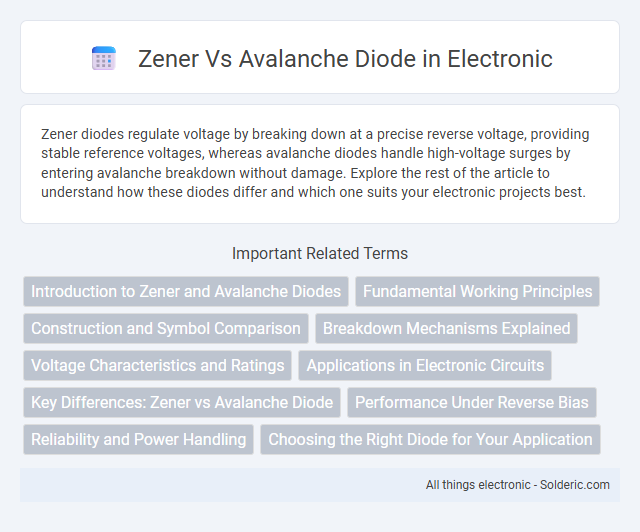Zener diodes regulate voltage by breaking down at a precise reverse voltage, providing stable reference voltages, whereas avalanche diodes handle high-voltage surges by entering avalanche breakdown without damage. Explore the rest of the article to understand how these diodes differ and which one suits your electronic projects best.
Comparison Table
| Feature | Zener Diode | Avalanche Diode |
|---|---|---|
| Breakdown Mechanism | Zener Breakdown (Quantum Tunneling) | Avalanche Breakdown (Carrier Multiplication) |
| Breakdown Voltage Range | Typically 2.7V to 200V | Generally above 5V |
| Reverse Voltage | Operates at a precise reverse voltage (Zener voltage) | Operates at higher reverse voltages |
| Application | Voltage regulation, voltage reference | Surge protection, voltage clamping |
| Temperature Stability | Good at low voltages, negative temperature coefficient | Better stability at higher voltages, positive temperature coefficient |
| Symbol | Standard diode symbol with bent bar | Standard diode symbol like Zener, but designed for avalanche usage |
Introduction to Zener and Avalanche Diodes
Zener diodes operate by utilizing the Zener breakdown mechanism, allowing precise voltage regulation at low reverse voltages typically below 7V, making them ideal for voltage reference applications. Avalanche diodes function based on the avalanche breakdown effect occurring at higher reverse voltages, suitable for surge protection by safely conducting excess current. Both diodes are designed to operate in reverse breakdown region, but differ in breakdown voltage ranges and application use cases.
Fundamental Working Principles
Zener diodes operate by exploiting the Zener breakdown effect, where a controlled breakdown occurs at a precise reverse voltage, allowing current to flow without damaging the diode. Avalanche diodes rely on the avalanche multiplication process, where carriers gain enough energy under high reverse voltage to generate secondary electron-hole pairs, leading to a large current flow. Both diodes are designed for voltage regulation and protection but differ fundamentally in their breakdown mechanisms and voltage stability characteristics.
Construction and Symbol Comparison
Zener diodes and avalanche diodes share similar construction as heavily doped p-n junctions but differ in their breakdown voltage mechanisms; Zener diodes operate based on quantum mechanical tunneling at lower breakdown voltages, while avalanche diodes rely on impact ionization at higher voltages. The Zener diode symbol features a bent line at the cathode to indicate its controlled breakdown characteristic, whereas the avalanche diode symbol resembles a standard diode with additional markings or a slanted bar to denote avalanche breakdown capabilities. Understanding these differences in construction and symbols helps you accurately select diodes for voltage regulation or protection in your electronic circuits.
Breakdown Mechanisms Explained
Zener diodes undergo breakdown primarily due to the Zener effect, where a strong electric field causes electron tunneling across a narrow depletion region at low breakdown voltages (typically below 5V). Avalanche diodes experience breakdown via the avalanche effect, where carriers gain enough kinetic energy under high reverse voltage to ionize atoms, resulting in a chain reaction and higher breakdown voltages (above 5V). Understanding these distinct mechanisms helps you select the right diode for voltage regulation or surge protection applications.
Voltage Characteristics and Ratings
Zener diodes maintain a stable breakdown voltage typically ranging from 2.4V to several hundred volts, designed for precise voltage regulation in reverse bias operation. Avalanche diodes have higher breakdown voltages, often above 6V, and rely on avalanche multiplication, characterized by a less sharp breakdown compared to Zener diodes. Voltage ratings of Zener diodes ensure tight tolerance around the breakdown voltage, while avalanche diodes have broader voltage tolerances and are optimized for protecting circuits from high-voltage transients.
Applications in Electronic Circuits
Zener diodes are primarily used in voltage regulation and reference applications, providing stable voltage levels in power supplies and voltage clamping circuits. Avalanche diodes are designed to protect circuits from high-voltage transients by operating in the avalanche breakdown region, making them ideal for surge protection and voltage spike suppression. Both diodes serve critical roles in safeguarding sensitive components and maintaining circuit stability in electronic designs.
Key Differences: Zener vs Avalanche Diode
Zener diodes operate primarily through Zener breakdown at low reverse voltage, enabling precise voltage regulation in low-voltage applications, typically under 5-6V. Avalanche diodes, on the other hand, function via avalanche breakdown at higher reverse voltages, providing robustness in high-voltage surge protection and transient voltage suppression. The distinct breakdown mechanisms result in different voltage ranges, stability, and response times, with Zener diodes offering tight voltage regulation and avalanche diodes excelling in energy absorption during voltage spikes.
Performance Under Reverse Bias
Zener diodes exhibit stable voltage regulation under reverse bias by operating in the Zener breakdown region, enabling precise voltage reference with minimal noise. Avalanche diodes, triggered by avalanche breakdown at higher reverse voltages, offer robust transient voltage suppression but with less voltage precision compared to Zener diodes. Both devices effectively manage reverse bias conditions, with Zener diodes preferred for low-voltage regulation and avalanche diodes suited for high-voltage surge protection.
Reliability and Power Handling
Zener diodes offer high reliability in voltage regulation applications due to their precise breakdown voltage, making them ideal for low to moderate power scenarios. Avalanche diodes excel in power handling capabilities, safely dissipating higher energy during transient voltage spikes, which enhances circuit protection under demanding conditions. Choosing between these diode types depends on your application's reliability needs and power tolerance requirements.
Choosing the Right Diode for Your Application
Selecting between a Zener diode and an avalanche diode depends on your application's voltage regulation and protection needs. Zener diodes are ideal for precise voltage regulation in low reverse voltage scenarios, while avalanche diodes excel in high-voltage surge protection and transient voltage suppression. Understanding the specific electrical characteristics and breakdown voltages ensures your circuit's reliability and efficiency with the right diode choice.
zener vs avalanche diode Infographic

 solderic.com
solderic.com